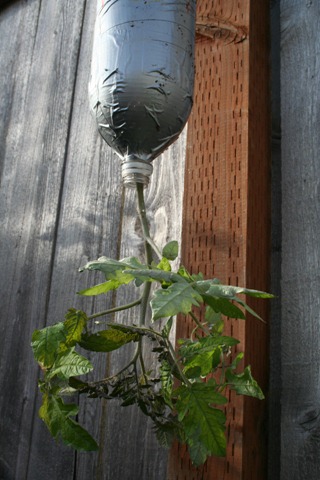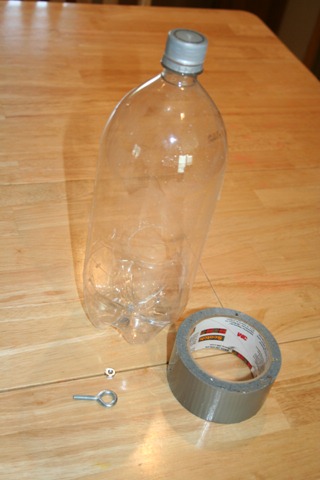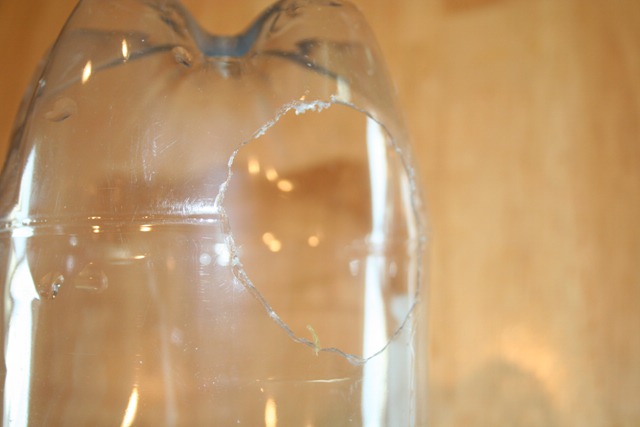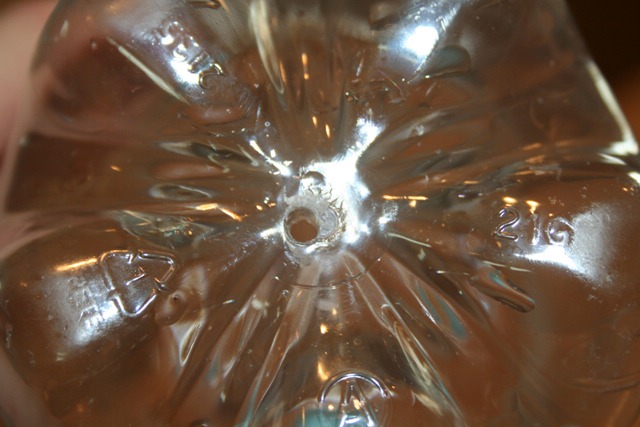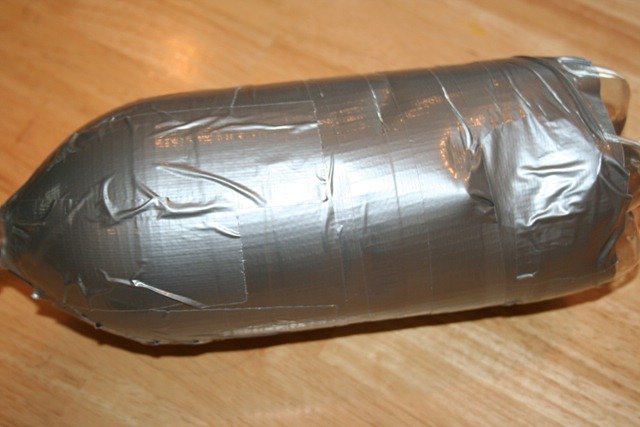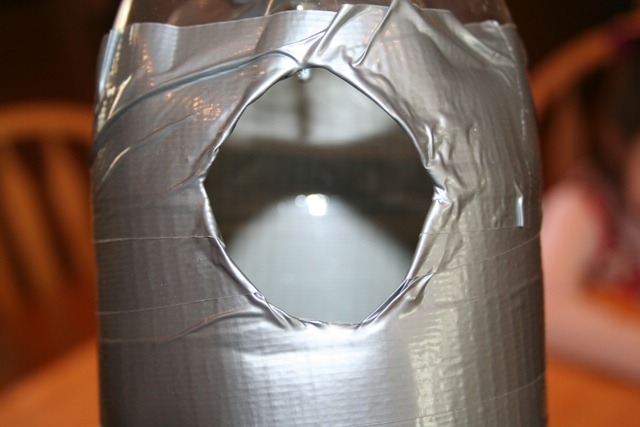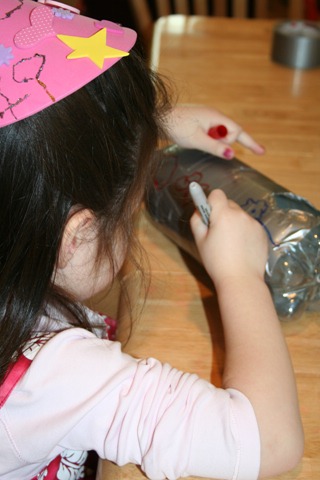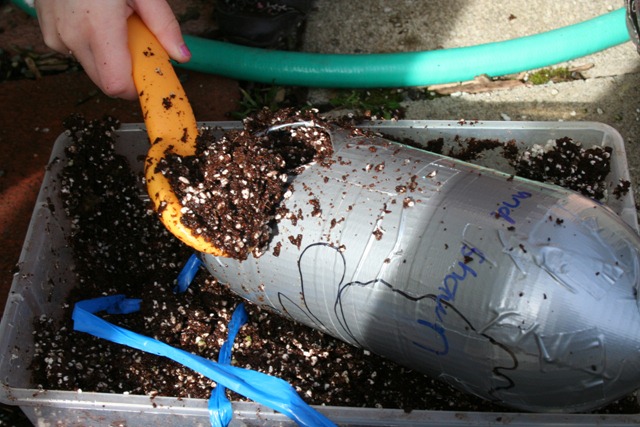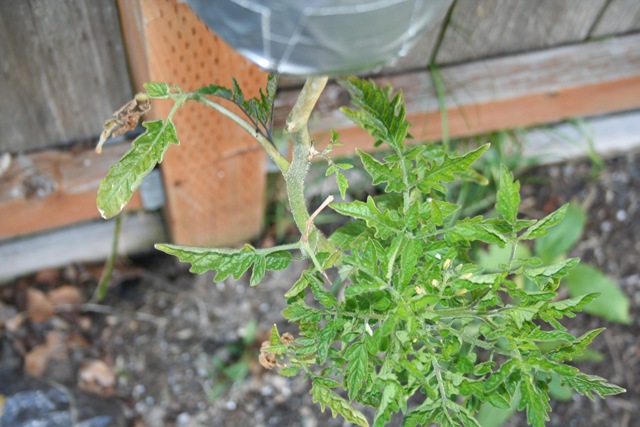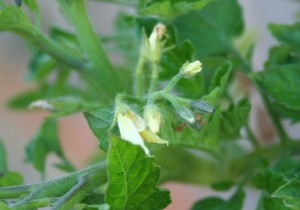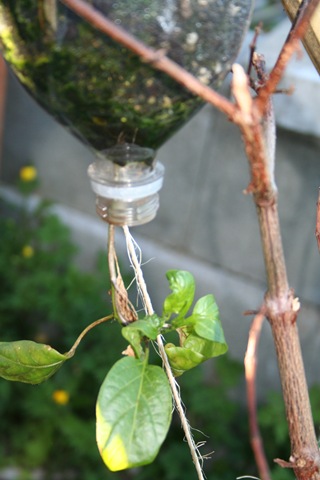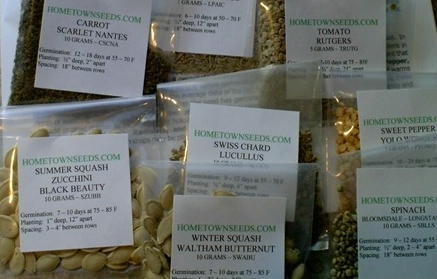How to build a raised vegetable garden
14.9 years ago garden planning, raised garden
Building a raised vegetable garden is a very easy and with the right planning can also be very inexpensive. First you need to answer a few important questions before you get started.
The first you have to pick a location. There are a few things to keep in mind when choosing the location; sun, water, convenience, and competition for nutrients.
SUN – You want to pick a location where the plants will get adequate sun for success. If this is an area where you will be growing summer vegetable a southern facing location should be used. For other cooler crops East/West facing should suffice.
WATER – You want a place that is convenient to water your plants. If you have to unravel/coil up 200 feet of hose every time you water you most likely will begin to have under watered plants during the summer months. If a hose is not really even an option the method of filling a couple five gallon buckets and bringing them to your garden is great exercise.
CONVENIENCE — The more often you walk by your garden the more likely you will not forget about (or neglect it) If it happens to pass it on your trip from my car to your back door you most likely will notice suffering plants or potential additions for tonight’s dinner to harvest.
COMPETITION FOR NUTRIENTS — Make sure your garden is not too close to other planting such as established plants or trees. This will force both sets of plants roots to compete for water and nutrients where both may end up coming up short.
Now you know where to build your garden next is to determine the best materials to build you garden out of. Personally I like cinder blocks since they never have to be replaced, relatively inexpensive, have ability to hold solar energy and as an added bonus have great little holes to grow strawberries in. Now on the negative side I will be the first to admit they are not the prettiest thing to look at and don’t really make the most comfortable bench to sit on.
Below I have included some of the pro and cons of various building materials.
| Building Material | Cost per linear foot | Tools required | Pros | Cons |
| Cinder Blocks | $0.97 | None (other big muscles) | Extra plating area in holes | Hard to sit on, not as aesthetically pleasing |
| Chiseled Wall blocks (2 high) |
$5.96 | None (other big muscles) | Most aesthetically pleasing | Expensive |
| Bricks (3 high) |
$1.36 | None (if dry stacked) | More aesthetically pleasing than cinder blocks | Expensive, and mortar may be required depending on height |
| Wood — Cedar (.75” X 8”) |
$1.60 | Drill (screws) | Looks good, natural appearance | Wood is organic so eventually will decompose. Some assembly required |
Third step is actual construction of your raised garden bed. I agree with Mel Bartholomew’s recommendation (from Square Foot Gardening fame)where he suggests limiting the width of the garden bed to no greater that 4 feet. This allows for easy watering, weeding, and harvesting of your vegetables without any serious reaching. This also works out good since lumber normally comes in 8 or 12 foot increments so very limited waste.
For all methods I recommend digging about 2 inches around your perimeter of your planned raised garden bed. This first will give you a visual idea of your new space but also give the blocks/bricks/wood a good foundation to prevent slipping. Speaking of foundation the weight of block/bricks is enough to keep the dirt in place, though with wood I would recommend creating a 4 foot 1X1 as a cross support every 4 feet to help spread out some of the load as you add soil.
Finally it is time to fill your your garden bed with some great soil. If you happen to be luck enough to have this in your backyard go ahead and fill it up. For the rest of us this is a great time to start your garden off to a good start. I recommend a recipe of three main parts (compost, filler, and “fluff”) of equal quantities. Compost should be self explanatory, great organic material thriving with life. For filler I recommend materials like coconut coir, peat moss, or even some good topsoil. For “fluff” add a material such as perlite or vermiculite to add some moisture retention and some great aeration for your plants roots.
Now all my recommendations above all mention a height of less than 12 inches. There are some good reasons for this given there are not too many vegetables you can’t grow in less than six inches of good quality soil. Assuming you are lucky like me and have an abundance of clay in your backyard this means significantly less soil to purchase when filling. Now this is harder on the back bending over so for someone with limited mobility you can bring up the garden bed to a more comfortable height though there really is no reason to fill the garden bed with 2-3 feet of soil. This is an area to be creative, maybe some free fill dirt for the first couple feet, aluminum cans, anything that can take up space and not use your precious garden soil.
Now if your selection of tools are limited or you just want to get some beds up quickly to start growing some vegetables, there are a many commercial raised garden kits out there.
Tags: compost, led, organic vegetables, outdoor plants, raised garden, strawberry plants, vegetables
Mulch your garden with human hair
15 years ago Uncategorized
Need a renewable mulching source that is completely renewable? Check your shower drain.
After spending 18 years as a hair stylist, Phil McCrory got an idea. He developed “SmartGrow” – mats woven from human hair. The product is becoming a popular organic alternative to chemical herbicides
If you don’t have the time to collect and weave your own human hair mats you can always purchase one from SmartGrow from under $4.00 to over $15.00 depending on the size you need.
Tags: organic vegetables
Make your own upside down tomato planter
15 years ago cheap, peppers, tomato
Every time my daughter sees the upside down tomato planter (Topsy Turvy) commercial on TV she asks when we can grow tomatoes upside down. I am definitely not one to pay $15 to $20 to buy one of these things in the store when I could have the fun of making my own for much less money.
Though this has been commercialized recently, the concept growing plants upside down is not a new one. Many people have been growing plants like tomatoes in 5 gallon buckets or hanging baskets for decades. Not having any spare bucket or hanging basket to sacrifice I went with my daughters suggestion and used a 2 liter bottle.
Materials required for you upside down tomato planter
- Empty 2-liter bottle
- Eye bolt with washer
- Duct tape, contact paper, or spray paint
- Drill or hot nail
Step 1 — Create access hole
Make a hole on the side of bottle, this has two purposes: it allows adding soil much easier and also provides an convenient way to water your plant. I used a 2-inch hole cutter, though you may also carefully cut a hole with a knife.
Step 2 — Add the hanger
By design 2-liter bottles are extra thick in on the bottom immediate center which will make a perfect place to hang it. I used a drill of the same diameter as the eye bolt. This allowed me to thread the bolt right into the bottle, which was pretty strong it itself. Though expecting a great harvest, I also added a bolt to prevent the discovery of my plant on the ground after having a hard fall.
Step 3 — Covering your planter
Roots can be damaged if exposed to light for long periods of time so you need to cover your planter. You should consider color depending on where you live. In colder regions a darker color will help keep the soil warm on cool mornings, though in hotter climates a dark color could fry the plant. I would recommend a medium to light green color for moderate heat absorption and little more aesthetically pleasing in the garden. Not having any paint I used good ole duct tape. Wrapping around the entire bottle (even covering the access hole.
I then cut an X through the access hole and bent the corners in to soften the rough edges caused by cutting the hole.
Step 4 — Decorate (optional unless you have kids)
We used permanent markers to personalize both of my daughters upside down tomato planters.
This completes the construction of your upside down tomato planter. I will admit the first design flaw of this planter is its size. It will be fine for root growth but it can dry out very quickly. In response to this water retention was my primary concern when deciding on medium to fill the planters with.
I chose 2 parts (peat moss or coconut coir okay substitutes) , 1 part perlite, and 1 part Groden granulates. WonderSoil it contains coconut coir which retains water well but also contains water retaining polymers. The perlite and Groden granulates both provide water retaining properties an allow for proper aeration for easy unrestricted root growth.
To give the plants a good head start I also mixed in a couple of tablespoons of bone meal and tablespoon of balanced organic fertilizer. Add some water until the mix has the consistency of a wrung out sponge .
Lastly I used my tomato plants from my hydroponic experiment and carefully fed the roots into the now bottom opening of the bottle. We then added our soil mix until it reached the bottom of the access hole. Given the plants had a well established root system just the friction and weight of the soil is enough to keep the plant from falling out
Even though the medium retains water well the plants should be watered every day to the point until some water comes out the bottom. Within 24 hours we can already see the leaves turning over to face the sun.
You can also try other heat loving plants such as peppers, cucumbers, and zucchini. So if you every wanted to try growing plants upside down with the directions above you can have your own for less than $0.50.
If you want something a little more aesthetically pleasing there is always the commercial option, this one from Gardener’s Supply seems much more sturdy than the ones I have seen on TV:
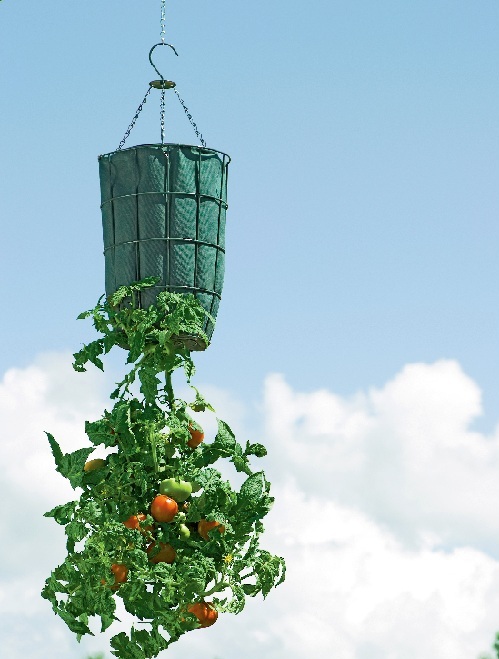
UPDATE: 05/24/09
It has finally started to get a little warmer at night in my garden so seems like a good time for a little update on the upside down tomato planter. I wish I could give a direct comparison of the growth of these plants with plants a planted at the same time in the ground though unfortunately we had a light freeze that killed them off. Interesting enough both plants in the upside down tomato planter survived and even are showing some small blossoms.
Now as part of my pepper planting experiment, I also put a pepper plant in an upside down tomato planter with much less exciting success. Just to test if my super paranoid water retention worries had any backing I simply filled this one with regular potting mix. And the plant dried out very quickly which shows in the following results.
Given these results I am going to stick with my 2 parts WonderSoil (peat moss or coconut coir okay substitutes) , 1 part perlite, and 1 part Groden granulates recipe in the future.
Tags: cheap, led, organic vegetables, outdoor plants, pepper plants, tomato plants, upside down tomato planter, vegetables
Grocery store Vegetables are not as nutritious as they used to be?
15.2 years ago grocery store, organic
“University of Texas, Austin. Davis claims the average vegetable found in today’s supermarket is anywhere from 5% to 40% lower in minerals (including magnesium, iron, calcium and zinc) than those harvested just 50 years ago.”
Not only are those vegetables you been eating at the grocery store less tasty, but may be getting marginal nutritional value. They discuss some of the potential factors in this including use for synthetic fertilizer and the desire to achieve higher yield during a shorter timetable, unfortunately the poor plants do not have time to absorb the beneficial minerals (as do we)
This article is timely with my Chemistry of Gardening — What nutrients do plants need? post. If you have sufficient primary macronutrients (NPK) which is the primary contents on synthetic fertilizer you can still have great yields and fast growing plants but quality of plants are reduced. What the problem appears to me, is the secondary macronutrients are not being supplemented (magnesium, iron, calcium and zinc) which is causing the nutrient/taste deficiency. Organic methods natural provide these nutrients by the addition of organic matter to the soil.
I am cheap and organic vegetables are expensive, this is definitely a case of you get what you pay for. Hope is still here you can easily grow your own organic vegetables at home. If you still think growing your own vegetables is a bad idea here are a list of benefits from buying at the grocery store:
- Continue to rise in cost so you won’t have to worry what to do with your extra money
- No confusion with the small variety available (transport well)
- They don’t taste as good, so no guilt in enjoying eating your veggies
- Less of those pesky minerals for your body to absorb
- Opportunity of getting a trip to the ER after picking up salmonella
In all seriousness this is a scary development where people could be malnourished even with a decent supply of fruits and vegetables.
Tags: cheap, cilantro, organic vegetables, outdoor plants, vegetables
Chemistry of Gardening: What nutrients do plants need?
15.2 years ago alfalfa pellets, fertilizer, outdoor seed starting
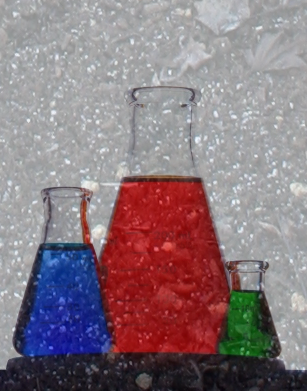 If I ask my four year old what it takes for a plant to grow she can quickly respond with response, “Sun, water, air, and soil” This is a great answer for photosynthesis since plants need energy from the sun. They leverage the carbon dioxide (CO2) from the air and water (H2O) to create starches and sugar. Now the soil part of this answer is where things get a little more complicated. Soil gives plants the ability for roots to expand and grow but also provides many nutrients to help them as well.
If I ask my four year old what it takes for a plant to grow she can quickly respond with response, “Sun, water, air, and soil” This is a great answer for photosynthesis since plants need energy from the sun. They leverage the carbon dioxide (CO2) from the air and water (H2O) to create starches and sugar. Now the soil part of this answer is where things get a little more complicated. Soil gives plants the ability for roots to expand and grow but also provides many nutrients to help them as well.
Similar to humans, plants need various minerals to live healthy lives. The primary macronutrients Nitrogen (N), Phosphorus (P), Potassium (K) are required to sustain life. These are the nutrients that plants consume significant amounts which is why these are advertised in big letters on the outside of packages of fertilizer.
MACRONUTRIENTS – PRIMARY
| Nutrients | Benefits | Signs of Deficiency | Sources (N-P-K) |
| Nitrogen (N) | Provides energy to allow vegetative growth. Leafy plants can’t get enough, root plants need very little, fruiting plants need plenty in beginning but too much later in growth cycle will result in big/tall fruitless plants. | Light green to yellow leaves; growth stunted | Bloodmeal (14-0-0) Alfalfa meal (7-3-4) Soybean meal (6-1-2) Cottonseed meal (6-2-2) Fish emulsion (5-2-2) Chicken Manure (3-4-3) Compost (1-1-1) Cow Manure (.2-.2-.2) |
| Phosphorus (P) | Makes plants more stress resistant, allows for fast growth, encourages bloom and root growth. | Red or Purple leaves; cell division slowed | Bonemeal (4-12-0) Chicken Manure (3-4-3) Alfalfa meal (7-3-4) Compost (1-1-1) |
| Potassium (K) | Helps with photosynthesis process, immunities to disease, and increased quality of fruit. | Vigor reduced; susceptible to disease; thin skin; small fruits | Alfalfa meal (7-3-4) Greensand (0-0-3) Wood ash (0-1-3) Chicken Manure (3-4-3) Compost (1-1-1) |
We could live off a simple food like gummy bears for quite a while, but our quality life will decrease once we picked up scurvy and exhibit significant bone and muscle loss. The same idea goes for plants, they can live simply on the primary macronutrients but they will live poor and possibly fruitless (literally) lives. This is where the secondary nutrients come in. With the exception of Calcium, these are not consumed in nearly the volumes as the primary macronutrients though supplementation may be required.
MACRONUTRIENTS – SECONDARY
| Nutrients | Benefits | Signs of Deficiency | Sources |
| Calcium (Ca) |
Helps with cell wall structure imperative for strength of plants |
Growing points of plants damaged | Dolomitic limestone, gypsum, egg shells, antacids |
| Magnesium (Mg) | Required as part of the chlorophyll required for photosynthesis | Yield down; old leaves white or yellow | Epsom salt, Dolomitic limestone, organic material |
| Sulfur (S) | Required for to allow plants to create protein, enzymes, and vitamins. Helps with seed, root growth, and resistance to cold. | Light green to yellow leaves; growth stunted | Rainwater, gypsum |
Finally are the macronutrients, these are the nutrients that most of the time, as long as you are not growing with hydroponics. should exist in your soil and rarely need to be supplemented due to the small amounts that are consumed by plants, nevertheless are still very important for plant growth.
MICRONUTRIENTS
| Nutrients | Benefits | Signs of Deficiency | Sources |
| Boron (B) | Helps in production of sugar and carbohydrate s. Essential for seed and fruit development. |
Small leaves; heart rot (corkiness); multiple buds | Organic Matter and borax |
| Copper (Cu) | Helps in plant reproduction | Multiple buds; gum pockets | Copper sulfate, neutral copper |
| Chloride (Cl) | Helps with plant metabolism | None known | Tap water |
| Iron (Fe) | Helps in formation of chlorophyll | Yellow leaves; veins remain green | Iron sulfate, iron chelate |
| Manganese (Mn) | Helps in breakdown of carbohydrates and nitrogen | Leaves mottled with yellow and white; growth stunted | Manganese sulfate, compost |
| Molybdenum (Mo) | Helps in breakdown of nitrogen | Varied symptoms | Sodium molybdate, compost |
| Zinc (Zn) | Regulates growth and consumption of sugars by the plant | Small, thin, and yellow leaves, low yield | zinc oxide, zinc sulfate, zinc chelate |
Nutrient Deficiency Information from “The Vegetable Gardener’s Bible”
Now you are armed with plenty of information, though unfortunately you can not act on any of this without knowing the chemical composition of your soil. If you simply went by the signs of deficiency (for example yellow leaves) could be caused by one or many nutrient deficiencies. Fortunately you can get this information to act on by running a soil test on your soil. There are a couple options for this if you are simply concerned about primary macronutrients there are cheap DIY home tests, electronic testers, or you can send a sample to a soil lab to give primary/secondary macronutrient and micronutrient levels and recommendations to get your soil back on track. You may also want to check with your local municipal office they may have a cheaper/free option available to you.
Just remember, your perceived lack of a green thumb my have nothing to do with your ability but the chemistry of soil you are working with.
Tags: alfalfa pellets, cheap, compost, garden seeds, led, organic vegetables, outdoor plants, vegetables
Cheap Vegetable Seeds
15.3 years ago cheap, coupon codes, free, seed saving, seeds
Looking at my web logs I have seen the query for “cheap vegetable seeds” a few times so figured would be good to help people find what they are looking for. Being The Cheap Vegetable Gardener, I can do better than “Cheap vegetable seeds” how about some “free vegetable seeds” as well.
Cheap Vegetable Seeds
- Buy online — You can find a much greater selection and some great prices compared to your local home and garden center. For example right now:
- One of my favorites is Burpee Seeds, they have been around since 1876 and definitely know their stuff. The actually have a seed sale going on now where you get $15 off on order of $75 (just use code AFFB4A35) expires on 1/15
.
- The name is not too exciting but Generic Seeds
offers no thrills packaging with quality seeds and very reasonable prices and if you spend $20 or more shipping is on them.
- One of my favorites is Burpee Seeds, they have been around since 1876 and definitely know their stuff. The actually have a seed sale going on now where you get $15 off on order of $75 (just use code AFFB4A35) expires on 1/15
Free Vegetable Seeds (pretty much)
- Ask your neighbors — Notice your neighbor is a gardener, check if they want to go in on a seed order and share unless you really need 200 carrots this year.
- Harvest your own seeds — If your plants bolt to seed early this year, don’t pull them out let them create some seeds for next season. Notice your neighbor has some seeding plants, ask if you can get some (important part is to ask though)
- Get seeds from the grocery store — Before putting those vegetables in the compost bin, set the seeds aside to let them dry and you got some free seeds. Though a word of warning many vegetables are hybrids and may be infertile or not produce the same quality of product but hey its free.
- Check your spice rack — Many cases you can plant seeds from your spice rack. Some ideas, mustard seed, dill seed, coriander, poppy seed, celery seed. If your spice rack is lacking you can pay a few cents buy a teaspoon of organic spices in bulk, last time I bought dill seeds got about 100 seeds for $0.05.
- Seed swap web sites — Below I have listed a few links where you can share seeds with others. This is a great way to find some heirloom seeds you might not be able to find in stores/seed catalogs. In many cases people will offer seeds for free by just sending a SASE (Self Addressed Stamped Envelope) Just remember to pay it forward when you come into a plethora of seeds yourself.
Tags: cheap, compost, garden seeds, organic vegetables, outdoor plants, vegetables
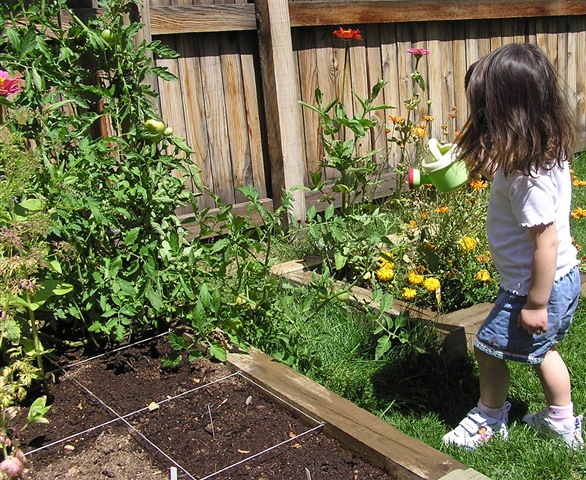
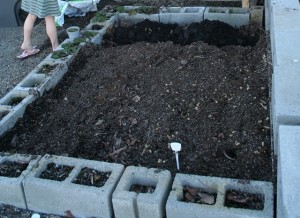
![image[5]](http://www.cheapvegetablegardener.com/wp-content/uploads/2009/05/image5.png)
